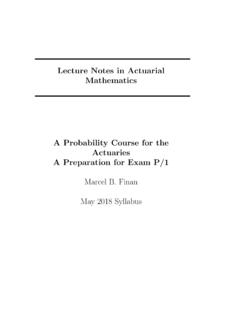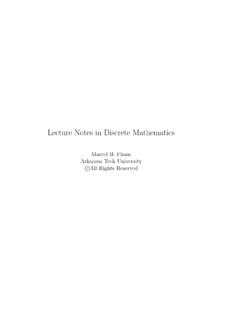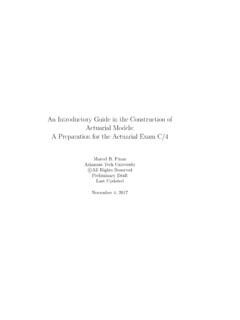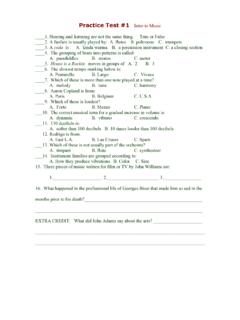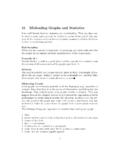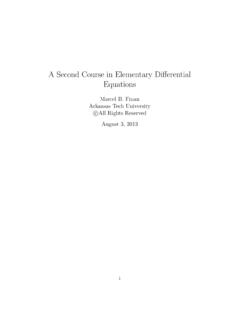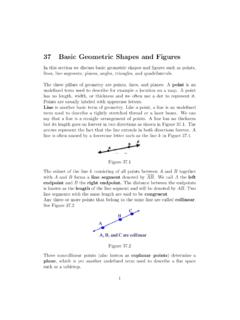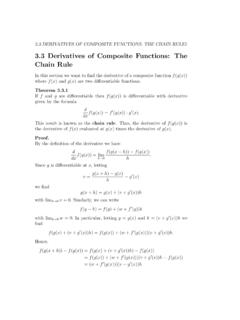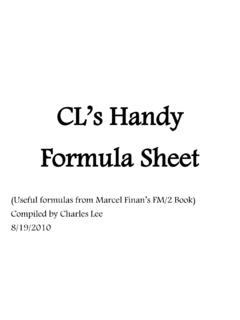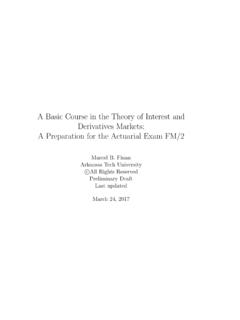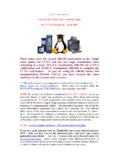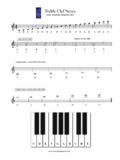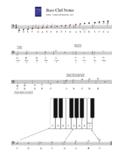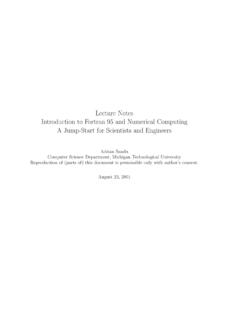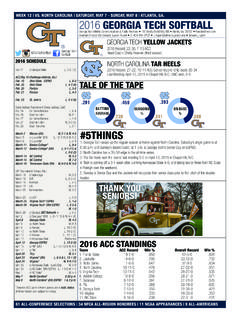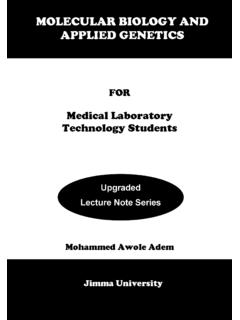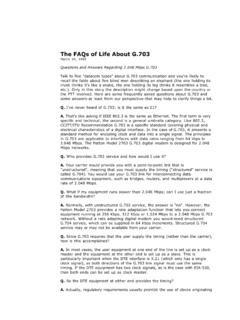Transcription of Marcel B. Finan Arkansas Tech University All Rights …
1 Laplace Transforms: Theory, Problems, andSolutionsMarcel B. FinanArkansas tech Universityc All Rights Reserved1 Contents43 The Laplace Transform: Basic Definitions and Results344 Further Studies of Laplace Transform1545 The Laplace Transform and the Method of Partial Fractions 2846 Laplace Transforms of Periodic Functions3547 Convolution Integrals4548 The Dirac Delta Function and Impulse Response5349 Solving Systems of Differential Equations Using Laplace Trans-form6150 Solutions to Problems68243 The Laplace Transform.
2 Basic Definitionsand ResultsLaplace transform is yet another operational tool for solving constant coeffi-cients linear differential equations. The process of solution consists of threemain steps: The given hard problem is transformed into a simple equation. This simple equation is solved by purely algebraic manipulations. The solution of the simple equation is transformed back to obtain the so-lution of the given this way the Laplace transformation reduces the problem of solving a dif-ferential equation to an algebraic problem.
3 The third step is made easier bytables, whose role is similar to that of integral tables in above procedure can be summarized by Figure this section we introduce the concept of Laplace transform and discusssome of its Laplace transform is defined in the following way. Letf(t) be definedfort theLaplace transformoff,which is denoted byL[f(t)]or byF(s), is defined by the following equationL[f(t)] =F(s) = limT T0f(t)e stdt= 0f(t)e stdtThe integral which defined a Laplace transform is an improper integral.
4 Animproper integral mayconvergeordiverge, depending on the the improper integral in convergent then we say that the functionf(t)possesses a Laplace transform. So what types of functions possess Laplacetransforms, that is, what type of functions guarantees a convergent the Laplace transform, if it exists, of each of the following functions(a)f(t) =eat(b)f(t) = 1 (c)f(t) =t(d)f(t) =et23 Solution.(a) Using the definition of Laplace transform we see thatL[eat] = 0e (s a)tdt= limT T0e (s a) T0e (s a)tdt={Tifs=a1 e (s a)Ts aifs6= the improper integral to converge we needs > this case,L[eat] =F(s) =1s a, s > a.}
5 (b) In a similar way to what was done in part (a), we findL[1] = 0e stdt= limT T0e stdt=1s, s >0.(c) We haveL[t] = 0te stdt=[ te sts e sts2] 0=1s2, s >0.(d) Again using the definition of Laplace transform we findL[et2] = 0et2 0 thent2 st 0 so thatet2 st 1 and this implies that 0et2 stdt the integral on the right is divergent, by the comparison theoremof improper integrals (see Theorem below) the integral on the left is alsodivergent. Now, ifs >0 then 0et(t s)dt the same reasoningthe integral on the left is divergent.
6 This shows that the functionf(t) =et2does not possess a Laplace transformThe above example raises the question of what class or classes of functionspossess a Laplace transform. Looking closely at Example (a), we noticethat fors > athe integral 0e (s a)tdtis convergent and a critical compo-nent for this convergence is the type of the functionf(t).To be more specific,iff(t) is a continuous function such that|f(t)| Meat, t C(1)4whereM 0 andaandCare constants, then this condition yields 0f(t)e stdt C0f(t)e stdt+M Ce (s a) (t) is continuous in 0 t C,by lettingA= max{|f(t)|: 0 t C}we have C0f(t)e stdt A C0e stdt=A(1s e sCs)<.
7 On the other hand, Now, by Example (a), the integral Ce (s a)tdtisconvergent fors > the comparison theorem of improper integrals (seeTheorem below) the integral on the left is also convergent. That is,f(t)possesses a Laplace call a function that satisfies condition (1) a function with anexponentialorder at , this means that the graph off(t) is containedin the region bounded by the graphs ofy=Meatandy= Meatfort also that this type of functions controls the negative exponential in thetransform integral so that to keep the integral from blowing up.
8 IfC= 0then we say that the function isexponentially that any bounded functionf(t) fort 0 is exponentially (t) is bounded fort 0,there is a positive constantMsuch that|f(t)| Mfor allt this is the same as (1) witha= 0 andC= ,f(t) has is exponentially boundedAnother question that comes to mind is whether it is possible to relax thecondition of continuity on the functionf(t).Let s look at the following that the square wave function whose graph is given in Figure a Laplace that the function is periodic of period (t)e st e st,we have 0f(t)e stdt 0e the integral onthe right is convergent fors >0 so that the integral on the left is convergentas well.
9 That is,L[f(t)] exists fors >0 The function of the above example belongs to a class of functions that wedefine next. A function is calledpiecewise continuouson an interval ifthe interval can be broken into a finite number of subintervals on which thefunction is continuous on each open subinterval ( the subinterval withoutits endpoints) and has a finite limit at the endpoints (jump discontinuitiesand no vertical asymptotes) of each subinterval. Below is a sketch of apiecewise continuous that a piecewise continuous function is a function that has a finitenumber of breaks in it and doesnt blow up to infinity anywhere.
10 A functiondefined fort 0 is said to bepiecewise continuous on the infinite in-tervalif it is piecewise continuous on 0 t Tfor allT > that the following functions are piecewise continuous and of exponentialorder at infinity fort 06(a)f(t) =tn(b)f(t) =tnsinatSolution.(a) Sinceet= n=0tnn! tnn!,we havetn n! ,tnis piecewise con-tinuous and exponentially bounded.(b) Since|tnsinat| n!et,we havetnsinatis piecewise continuous and ex-ponentially boundedNext, we would like to establish the existence of the Laplace transform forall functions that are piecewise continuous and have exponential order atinfinity.
